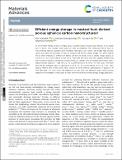Files in this item
Efficient energy storage in mustard husk derived porous spherical carbon nanostructures
Item metadata
| dc.contributor.author | Pramanik, Atin | |
| dc.contributor.author | Chattopadhyay, Shreyasi | |
| dc.contributor.author | De, Goutam | |
| dc.contributor.author | Mahanty, Sourindra | |
| dc.date.accessioned | 2021-10-18T13:30:01Z | |
| dc.date.available | 2021-10-18T13:30:01Z | |
| dc.date.issued | 2021-09-13 | |
| dc.identifier | 276280226 | |
| dc.identifier | 4d6145ea-9b9c-4024-9663-b389202ae6fb | |
| dc.identifier | 000703454700001 | |
| dc.identifier | 85118568864 | |
| dc.identifier.citation | Pramanik , A , Chattopadhyay , S , De , G & Mahanty , S 2021 , ' Efficient energy storage in mustard husk derived porous spherical carbon nanostructures ' , Materials Advances , vol. Advance Article . https://doi.org/10.1039/d1ma00679g | en |
| dc.identifier.issn | 2633-5409 | |
| dc.identifier.other | RIS: urn:825D08EBDCF812668CDBBD5251E2F3D9 | |
| dc.identifier.uri | https://hdl.handle.net/10023/24153 | |
| dc.description | A. P. thanks CSIR India for a senior research fellowship (Award No. 31/15(136)/2017-EMR-I). S. C. thanks UGC, India for a research fellowship (Award No. F.2-44/2011(SA-I)). | en |
| dc.description.abstract | An environment-friendly synthesis of highly porous spherical carbon nanostructures (PSCNs), in situ doped with N and S, from mustard seed waste has been accomplished. The synthesised PSCNs have an interconnected network, abundant active interfaces, heteroatom rich content, and notably high porosity/surface area which are favourable for fast ion transport and efficient charge storage. This active material (PSCN), when employed as a lithium-ion battery (LIB) half-cell anode, shows a specific charge capacity of 714 mA h g−1 at a current density of 100 mA g−1 even after 550 cycles with 112% capacity retention and high restoration capability. Furthermore, PSCN//LiFePO4 full cell LIBs show an excellent performance with a highly reversible capacity of ∼195 mA h g−1 at a current density of 50 mA g−1 for 400 cycles. The PSCN electrode also exhibited a specific capacitance of 257.8 F g−1 at a current density of 0.1 A g−1 with ∼93% capacity retention after 10 000 cycles, when used as an electrochemical supercapacitor in aqueous 3 M KOH electrolyte. This work shows the preparation of high value and advanced carbon nanostructured material from renewable bio-mass waste for high-performance electrochemical energy storage applications. | |
| dc.format.extent | 10 | |
| dc.format.extent | 3908016 | |
| dc.language.iso | eng | |
| dc.relation.ispartof | Materials Advances | en |
| dc.subject | QD Chemistry | en |
| dc.subject | NDAS | en |
| dc.subject | SDG 7 - Affordable and Clean Energy | en |
| dc.subject.lcc | QD | en |
| dc.title | Efficient energy storage in mustard husk derived porous spherical carbon nanostructures | en |
| dc.type | Journal article | en |
| dc.contributor.institution | University of St Andrews. School of Chemistry | en |
| dc.identifier.doi | 10.1039/d1ma00679g | |
| dc.description.status | Peer reviewed | en |
This item appears in the following Collection(s)
Items in the St Andrews Research Repository are protected by copyright, with all rights reserved, unless otherwise indicated.

